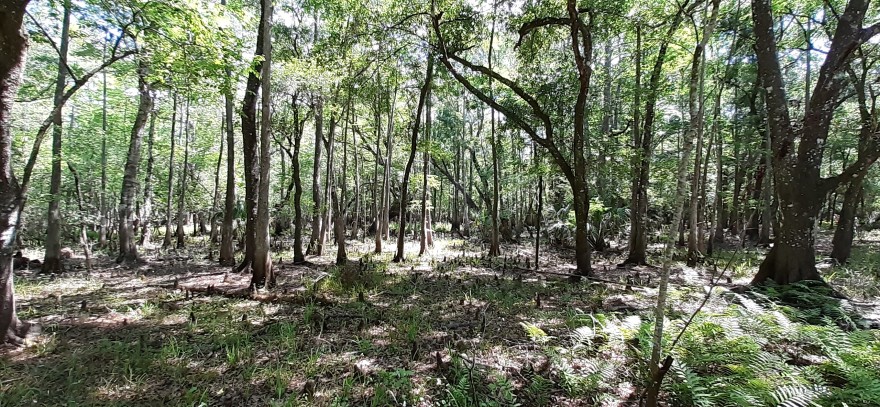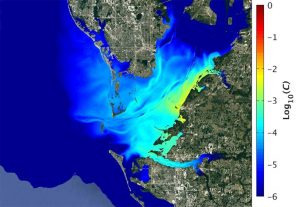|
Getting your Trinity Audio player ready...
|
Two environmental controversies provide USF Libraries with new opportunities for collecting and collaboration. In April of this year, incidents involving the USF Forest Preserve and Piney Point prompted new projects to support the Libraries’ Florida Environment and Natural History (FLENH) initiative launched by Dean Todd Chavez.
The USF Forest Preserve, located just north of the USF Tampa campus, is five hundred acres of wetland and sandhill habitat that is a haven for local birds, wildlife, wetlands, and trails. It acts as an outdoor classroom for field study and research for many USF students and faculty. The tract of wilderness includes some of the last sandhill habitat in Hillsborough County, and some of the only remaining wetlands and uplands in Tampa’s metropolitan area, which mitigate flooding. The land also contains archaeological artifacts that have yet to be fully explored and is home to Native American burial sites.
In April, USF issued a Request for Information (RFI) to assess options to develop the lands that encompass the USF Forest Preserve and the Claw Golf Course, totaling more than 760 acres. Developers had until Monday, May 24, 2021 to submit their proposals. USF administration has insisted that proposals would not necessarily be pursued, and according to USF’s statement to ABC Action News, they are “not required to take action on any of the proposals submitted by developers.”
USF students and faculty have taken it upon themselves to save the land from development by starting a petition that would allow it to continue to be home to the many plants and animals that currently reside there. The controversy over the various potential uses of the preserve reveals an underlying gap between the ideals of academia as reflected in environmental passions for the resources and the financial considerations driven by development.

Eyes are also on Piney Point, located in Manatee County, where an old phosphate plant recently released more than 200 million gallons of polluted water into Tampa Bay. The stream of wastewater is so rich in nutrients that it has made algal blooms and red tide flourish in Tampa Bay this summer, as Florida struggles to cope with the runoff and human waste caused by poor growth management and lack of regulations. Piney Point is not an isolated incident, but an outgrowth of a recurring crisis in the area.
For those who have followed the environmental history of Tampa Bay, phosphate is a familiar and unsettling word. Historically, the phosphate industry has struggled to operate safely. Although phosphate is used as plant fertilizer, it can wreak havoc on waterways and its byproducts can be hazardous. For those living around the gypsum stacks the phosphate industry leaves behind, it is a commonly held belief that it is not safe to drink local water for fear of illness. The basin of polluted water at Piney Point was drained in part to prevent the entire stack from failing, and two hundred homes were evacuated as a result. State and local government responses over the years have not addressed the underlying problems, and recent proposals for storing the contaminants deep underground have further alarmed environmentalists.

The USF Libraries are committed to gathering, archiving, and sharing research and archival materials about the USF Forest Preserve and Piney Point. Special Collections has built two new digital exhibits about the Forest Preserve and Piney Point, which include related archival, scholarly, and news resources. Recent data, stories, and research publications about both will also be hosted in our institutional repository, and the site will be continuously updated with the most recent research submitted. For those who are interested in donating materials or submitting their own research on the subjects should contact Special Collections Associate Librarian Andy Huse at ahuse@usf.edu.
These materials will join other environment and natural history collections such as the Environmental Lands Acquisition and Protection Program (ELAPP), which is currently in talks to help save the Preserve. ELAPP is a citizen-led group founded by Jan Platt, former Hillsborough County Commissioner and passionate advocate for libraries, that has protected over 61,000 acres of rare and important habitat in Hillsborough County. The USF Tampa Special Collections hosts the ELAPP Collection, which features its important conservation work from the 1990s to 2010s. The collection also contains oral history interviews with twenty of ELAPP’s founders and advocates.
This post was originally published on May 13, 2021 and recently updated to include the new Special Collections exhibits: Eyes on Piney Point and The University of South Florida Forest Preserve.